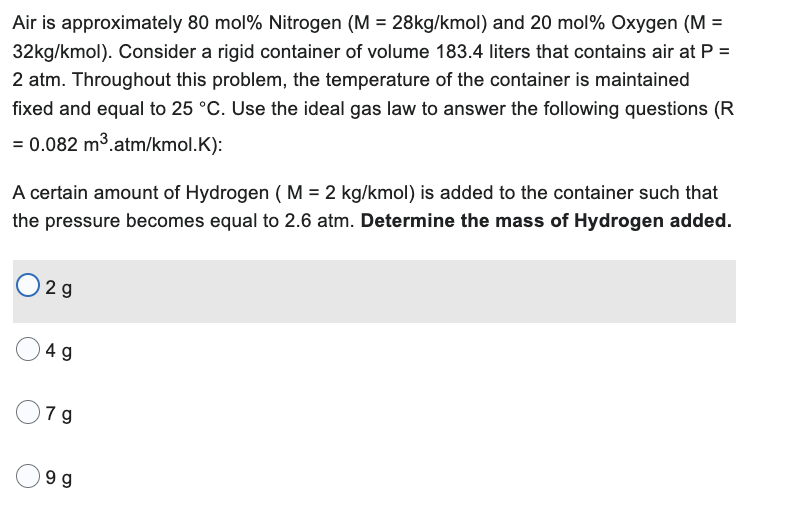Air is approximately 80 mol % Nitrogen (M = 28kg/kmol) and 20 mol% Oxygen (M = 32kg/kmol). Consider a rigid container of volume 183.4 liters that contains air at P = 2 atm. Throughout this problem, the temperature of the container is maintained fixed and equal to 25 °C. Use the ideal gas law to answer the following questions (R = 0.082 m³.atm/kmol.K): A certain amount of Hydrogen (M = 2 kg/kmol) is added to the container such that the pressure becomes equal to 2.6 atm. Determine the mass of Hydrogen added. O2g 49 7 g 9 g
Air is approximately 80 mol % Nitrogen (M = 28kg/kmol) and 20 mol% Oxygen (M = 32kg/kmol). Consider a rigid container of volume 183.4 liters that contains air at P = 2 atm. Throughout this problem, the temperature of the container is maintained fixed and equal to 25 °C. Use the ideal gas law to answer the following questions (R = 0.082 m³.atm/kmol.K): A certain amount of Hydrogen (M = 2 kg/kmol) is added to the container such that the pressure becomes equal to 2.6 atm. Determine the mass of Hydrogen added. O2g 49 7 g 9 g
Principles of Modern Chemistry
8th Edition
ISBN:9781305079113
Author:David W. Oxtoby, H. Pat Gillis, Laurie J. Butler
Publisher:David W. Oxtoby, H. Pat Gillis, Laurie J. Butler
Chapter12: Thermodynamic Processes And Thermochemistry
Section: Chapter Questions
Problem 79AP
Related questions
Question
219

Transcribed Image Text:Air is approximately 80 mol% Nitrogen (M = 28kg/kmol) and 20 mol% Oxygen (M =
32kg/kmol). Consider a rigid container of volume 183.4 liters that contains air at P =
2 atm. Throughout this problem, the temperature of the container is maintained
fixed and equal to 25 °C. Use the ideal gas law to answer the following questions (R
= 0.082 m³.atm/kmol.K):
A certain amount of Hydrogen (M = 2 kg/kmol) is added to the container such that
the pressure becomes equal to 2.6 atm. Determine the mass of Hydrogen added.
02g
4 g
79
9 g
Expert Solution
This question has been solved!
Explore an expertly crafted, step-by-step solution for a thorough understanding of key concepts.
Step by step
Solved in 2 steps

Knowledge Booster
Learn more about
Need a deep-dive on the concept behind this application? Look no further. Learn more about this topic, chemistry and related others by exploring similar questions and additional content below.Recommended textbooks for you

Principles of Modern Chemistry
Chemistry
ISBN:
9781305079113
Author:
David W. Oxtoby, H. Pat Gillis, Laurie J. Butler
Publisher:
Cengage Learning

Chemistry: The Molecular Science
Chemistry
ISBN:
9781285199047
Author:
John W. Moore, Conrad L. Stanitski
Publisher:
Cengage Learning

Chemistry & Chemical Reactivity
Chemistry
ISBN:
9781133949640
Author:
John C. Kotz, Paul M. Treichel, John Townsend, David Treichel
Publisher:
Cengage Learning

Principles of Modern Chemistry
Chemistry
ISBN:
9781305079113
Author:
David W. Oxtoby, H. Pat Gillis, Laurie J. Butler
Publisher:
Cengage Learning

Chemistry: The Molecular Science
Chemistry
ISBN:
9781285199047
Author:
John W. Moore, Conrad L. Stanitski
Publisher:
Cengage Learning

Chemistry & Chemical Reactivity
Chemistry
ISBN:
9781133949640
Author:
John C. Kotz, Paul M. Treichel, John Townsend, David Treichel
Publisher:
Cengage Learning

Chemistry & Chemical Reactivity
Chemistry
ISBN:
9781337399074
Author:
John C. Kotz, Paul M. Treichel, John Townsend, David Treichel
Publisher:
Cengage Learning

Physical Chemistry
Chemistry
ISBN:
9781133958437
Author:
Ball, David W. (david Warren), BAER, Tomas
Publisher:
Wadsworth Cengage Learning,

General Chemistry - Standalone book (MindTap Cour…
Chemistry
ISBN:
9781305580343
Author:
Steven D. Gammon, Ebbing, Darrell Ebbing, Steven D., Darrell; Gammon, Darrell Ebbing; Steven D. Gammon, Darrell D.; Gammon, Ebbing; Steven D. Gammon; Darrell
Publisher:
Cengage Learning